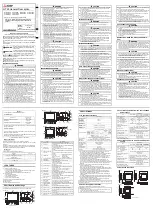
ETAS
ES441.1 - User Guide
24
No real-time requirements are made. Data acquisition on a PC, which generally
does not have to fulfil high real-time requirements, can thus be connected
directly to an ES400 chain. With a real-time-capable master, such as, for exam
-
ple, a Rapid Prototyping system, lots of different kinds of I/O signal can be
accessed with extremely short cycle times.
4.4.2
Realization
Time Slice Procedure
The modules in the daisy chain transfer the data to the master using a
100 MBit/s Ethernet connection time-controlled, i.e. without being prompted.
The PC assumes the function of the master. In the network, the modules
respond like a single Ethernet device with one MAC address.
All daisy chained modules have a generator which is only activated in the last
module of each chain after the test setup has been connected to the PC. The
frequency of the generator or the period duration of the time slices generated
can be set in the application program. It corresponds to the measuring fre
-
quency of the measurement channel with the highest acquisition rate in the
chain.
A binary counter linked to the generator periodically counts the time slices gen
-
erated (value range: 2
16
= 65536). The last module in the chain sends the rele
-
vant number of time slices in the IP header. The Ethernet frames are
transferred from module to module within the chain.
Each module in the chain receives bandwidth to transfer its measure data in
freely selectable time slices assigned within the period of the binary counter.
The module uses the number of the time slice to determine whether it can
insert an XCP message with its measure data into the current time slice.
The fastest module, which determines the period duration of the time slices
generated, transfers data in every time slice. An Ethernet frame then contains
at least one XCP-on-Ethernet data package. The length of the Ethernet frame
transferred inside a time slice increases with the number of modules which can
insert their data into this time slice.
The numbering of the time slices ensures, for example, that two modules which
work with half the sampling rate of the generator never attach their data to the
same Ethernet frame. One module uses only the odd frame numbers and the
other only the even ones. This mechanism also ensures for certain that the
assigned frames do not exceed the length of a time slice.
The measure data is automatically distributed to the frames so that the avail
-
able bandwidth is used perfectly.
NOTE
The communication protocol used by the ES400 family makes it possible for
third-party suppliers to use the communication protocol for their own, non-
ETAS applications once the modules have been configured with the „ES4xx
Configuration Tool from ES4xx_DRV_SW“ .
















































